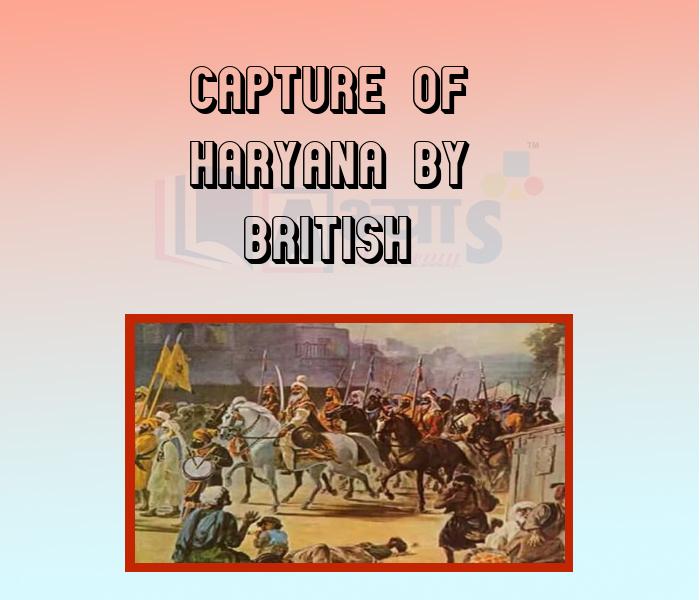Capture of Haryana By British












Capture Of Haryana By British
Modern History Of Haryana
History of Haryana is replete with tales of heroism of the highest order and in this context, the historic significance of the Battles of Panipat and Kurukshetra in Haryana cannot be ignored by any means.. After the Third Battle of Panipat in 1761, the Afghans returned to North and the Marathas had to the South, leaving the Sikhs and the Jats to fill the void. Delhi has always been the heart of political life of Haryana and the neighbouring territory. It underwent swift decline after the disintegration of the Mughal empire, starting from the early 18th century. The main steps in this direction were the sacking of Nadir Shah and Ahmad Shah Abdali, the Civil Wars of the nobility or feudal lords and the atrocities of Gulam Kadir. The situation was finally resolved by the British, who occupied the Mughal capital in 1803, after defeating the Marathas in its vicinity.
Capture Of Haryana By British
The year 1803 is an important year in the history of Haryana. In this year, the area of what is now present day Haryana and Delhi came under the control of the East India Company of Great Britain. At that time, Delhi was being ruled by the old and weak Mughal ruler, Shah Alam. But the real power lay in the hands of the Maratha leader, Daulat Rao Scindia, who acted as his regent. On 6th September, 1803, the battle between General Lake's British forces and the Marathas took place near village Partapganj. On 30th September, 1803, the Maratha leader Daulat Rao Scindia also decided to make peace with the British by signing a treaty with the East India Company known as Treaty of Surji-Anjangaon.
Consider the following statements I. Daulat Rao Scindia signed a peace Treaty with the British East India Company in 1803. II. According to the treaty, he has to surrendered some part of Haryana to the Company. Which of the following statements is/are correct ? | |||
| Right Option : A | |||
| View Explanation | |||
At which place in Haryana the battle between General Lake's British forces and the Marathas took place on 6th September, 1803 ? | |||
| Right Option : B | |||
| View Explanation | |||
Who was the British Governor-General when Haryana was captured by the British in 1803? | |||
| Right Option : C | |||
| View Explanation | |||
Students / Parents Reviews [10]
About Abhyas metholodology the teachers are very nice and hardworking toward students.The Centre Head Mrs Anu Sethi is also a brilliant teacher.Abhyas has taught me how to overcome problems and has always taken my doubts and suppoeted me.

Shreya Shrivastava
8thMy experience was very good with Abhyas academy. I am studying here from 6th class and I am satisfied by its results in my life. I improved a lot here ahead of school syllabus.

Ayan Ghosh
8thAbhyas Methodology is very good. It is based on according to student and each child manages accordingly to its properly. Methodology has improved the abilities of students to shine them in future.

Manish Kumar
10thIt was good as the experience because as we had come here we had been improved in a such envirnment created here.Extra is taught which is beneficial for future.

Eshan Arora
8thMy experience with Abhyas is very good. I have learnt many things here like vedic maths and reasoning also. Teachers here first take our doubts and then there are assignments to verify our weak points.

Shivam Rana
7thMy experience with Abhyas academy is very good. I did not think that my every subject coming here will be so strong. The main thing is that the online tests had made me learn here more things.

Hiya Gupta
8thAbhyas is a complete education Institute. Here extreme care is taken by teacher with the help of regular exam. Extra classes also conducted by the institute, if the student is weak.

Om Umang
10thI have spent a wonderful time in Abhyas academy. It has made my reasoning more apt, English more stronger and Maths an interesting subject for me. It has given me a habbit of self studying

Yatharthi Sharma
10thIt was a good experience with Abhyas Academy. I even faced problems in starting but slowly and steadily overcomed. Especially reasoning classes helped me a lot.

Cheshta
10thOne of the best institutes to develope a child interest in studies.Provides SST and English knowledge also unlike other institutes. Teachers are co operative and friendly online tests andPPT develope practical knowledge also.
